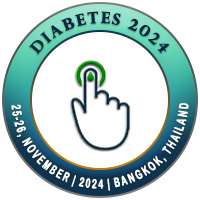O.B. Lukanovskaya
RUDN University, Moscow, Russian FederationTitle : Programmable births in gestational diabetes mellitus: minimizing risks — improving maternal and perinatal outcomes
Abstract
Background. Modernity is characterized by an avalanche-like increase in the frequency of gestational diabetes mellitus (in 4–5 times over the past 20 years). The main tasks of the work in the risk strategy of gestational diabetes mellitus are: prediction of pregnancy complications and the searchingh for new technologies for their delivery. To date, there are still very controversial questions about the timing and methods of delivery of patients with gestational diabetes mellitus. Due to the high incidence of unfavourable perinatal outcomes in gestational diabetes mellitus, the percentage of cesarean sections in some countries reaches 60%, which leads to maternal morbidity and a decrease in the reproductive health of the population. Aims — is to improve of maternal and neonatal outcomes based of the rational choice of delivery technology in gestational diabetes mellitus. Methods. A retrospective analysis of delivery methods was performed in 9769 patients with gestational diabetes mellitus at full-term gestation. Results. The developed and implemented programmed delivery technique was an alternative to cesarean sections, it allowed to reduce the frequency of abdominal delivery, while improving maternal and neonatal outcomes. The frequency of cesarean sections in programmed delivery was 2 times lower than in the presented facilities and significantly lower than in the population (10.0–10.7%). In the programmed delivery group there was a significant reducing morbidity of hypoglycemia in newborns compared to planned caesarean section — by 2 times and respiratory distress syndrome — by 2.5 times (p < 0.05). The indices of cerebral status impairment, birth traumatism corresponded to physiological childbirth and did not exceed the average population. Conclusions. The method of programmed delivery presented in this report was one of the reserves for reducing the frequency of cesarean sections and allowed to personalize delivery in respiratory distress syndrome. Keywords: gestational diabetes mellitus, programmed delivery, cesarean section For citation: Radzinsky VE, Startseva NM, Papysheva OV, Esipova LN, Oleneva MA, Lukanovskaya OB, Cheporeva ON, Tazhetdinov EKh. Programmable Births in Gestational Diabetes Mellitus: Minimizing Risks — Improving Maternal and Perinatal Outcomes.
Biography
Doctor of the highest category, candidate of medical sciences, member of the Gestational Diabetes Association. Obstetrician, head of the department of pathology of pregnancy, I provide assistance to pregnant women with diabetes. Our clinic in Moscow is specialized in diabetes mellitus in pregnant women, where up to 5,000 pregnant women with diabetes mellitus give birth every year. N.E. Bauman City Clinical Hospital No. 29, Moscow, Russian Federation

